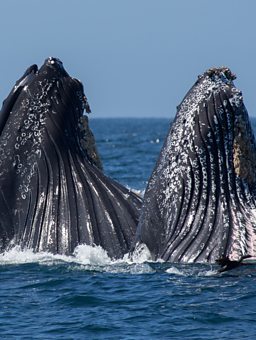Main content
Humpback whale
If the species of fish have swim bladders (as many do), the frequencies of the call resonate across the swim bladders, making it particularly uncomfortable for any fish that try to cross the bubbly 鈥榳all of sound'.
Song and dance routine/bubble netting:
- It has been known for some time that humpback whales use bubble nets to hunt prey. The whales dive deep, swim in a spiral, and blow a wall of bubbles. The wall encircles the prey, who do not cross the wall, and so are trapped, forming a convenient meal for the whales as they swim up from below, mouths agape.
- There had never been a satisfactory explanation as to why the prey did not leave the net until Professor Leighton (Southampton University) proposed that, if the whales emitted a particular frequency range when feeding, the sound could be trapped in the bubbly curtain, making a ‘wall of sound' that the prey would not cross.
- When he finally did find a recording of the particular call made by the whale when hunting with a bubble net, the frequencies used were correct. Computer models showed that sound could indeed be trapped in the net.
In using sound in this way, whales turn the survival instinct of fish (to form tight schools when startled) into an ‘anti-survival' instinct that allows them to be eaten.






